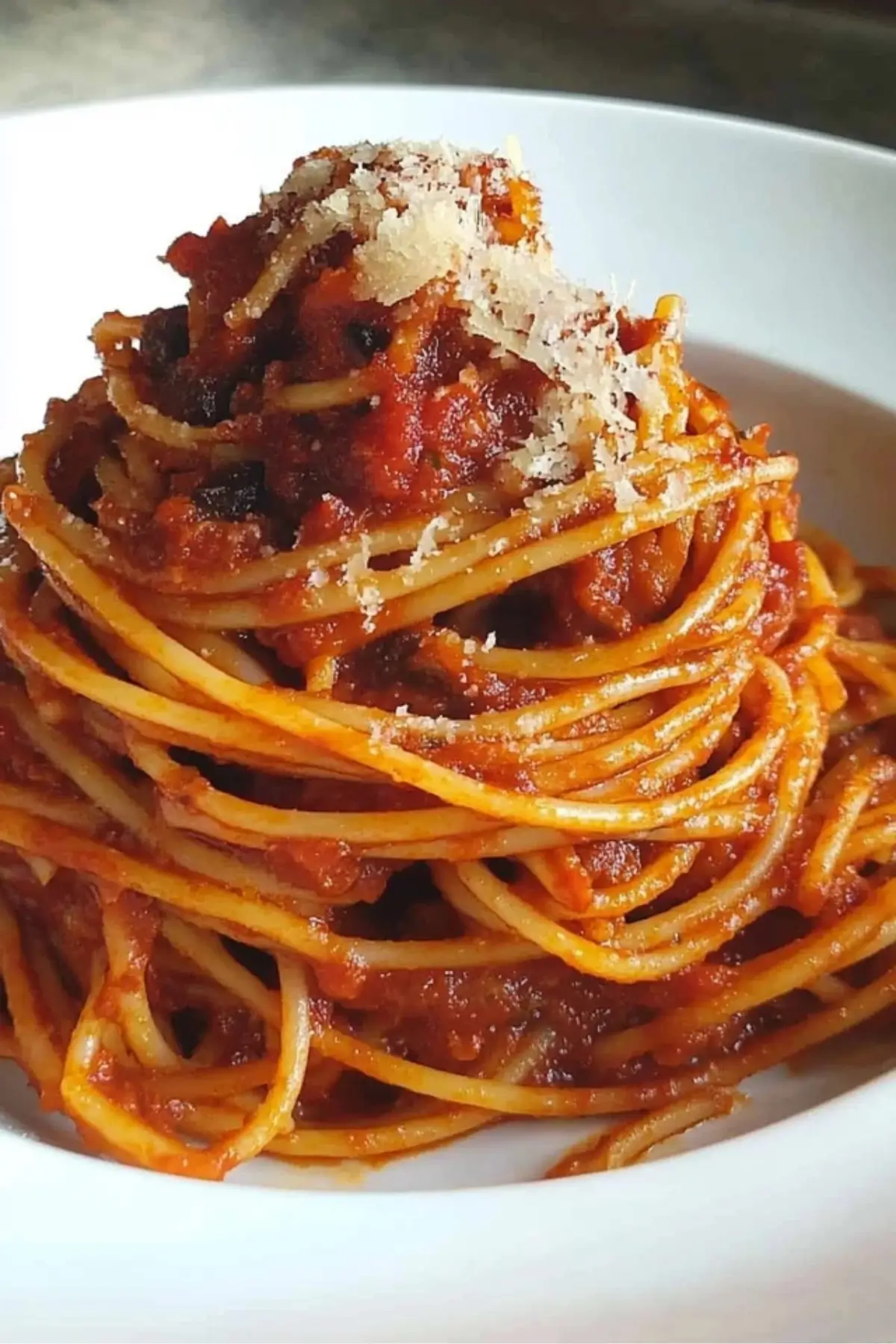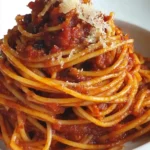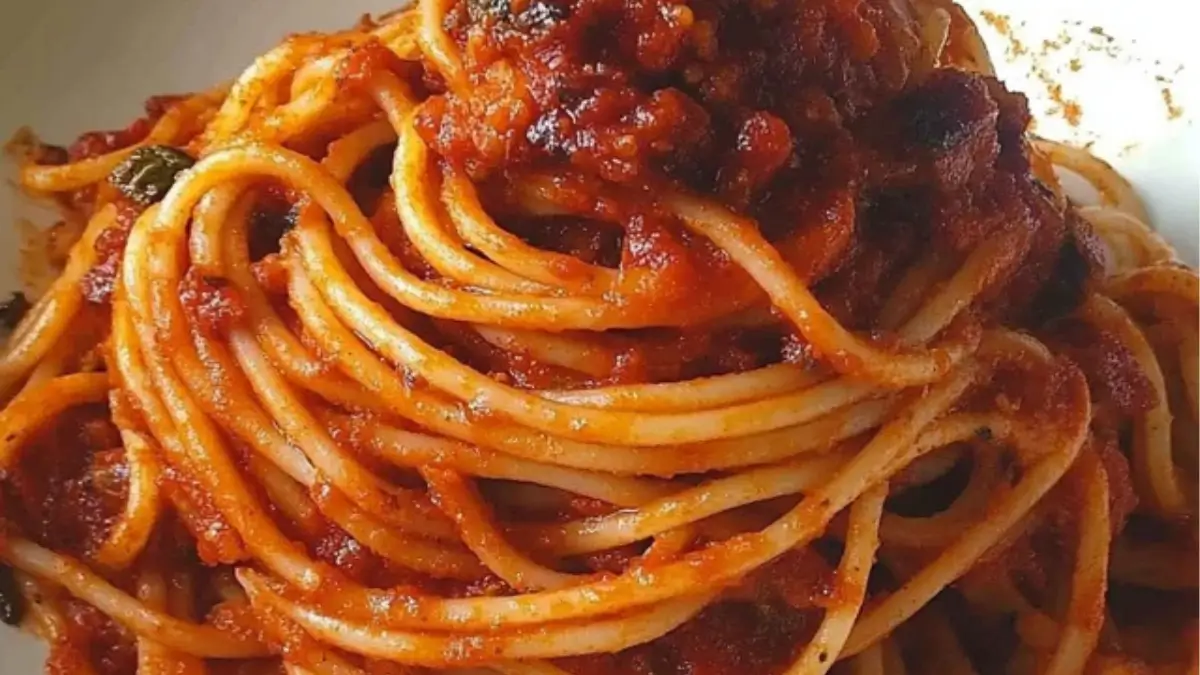It was a rainy Tuesday night when I first stumbled upon the story of Assassin’s Spaghetti. The name alone stopped me in my tracks—how could you not be intrigued? The tale goes that a slightly inebriated cook in Southern Italy, distracted by a beautiful woman, tossed dry spaghetti into a pan of simmering tomato sauce and forgot about it just long enough to let the noodles char. The result? A culinary accident turned delicious tradition.
This is not your average pasta. It’s fiery, bold, and packed with character. It’s also perfect for beginner cooks—minimal prep, no boiling water, and everything comes together in just one skillet. If you’re looking for a quick and healthy meal that’s rich in flavor and story, Assassin’s Spaghetti delivers.

Why This Recipe is Special
What makes this dish stand out isn’t just its name or origin story—it’s the unique pasta-cooked-like-risotto technique. By slowly ladling in tomato broth as the noodles cook and char against the hot pan, you get an unexpected combination of creamy, al dente strands with a crispy underside. It’s pasta with attitude.
The ingredients are humble, but the results are nothing short of impressive. For home cooks who want to try something new without getting overwhelmed, this easy sheet pan dinner alternative is a game-changer.
Ingredients and Preparation
Here’s what you’ll need to make Assassin’s Spaghetti. Don’t worry—we’ll explain each one so you understand why it’s there and how you can swap it if needed.
Garlic – The aromatic base. Minced garlic brings warmth and depth to the dish. Just be careful not to let it burn.
Red chili flakes – Adds a subtle kick and balances the sweetness of the tomato. Adjust to taste, or skip if you’re heat-sensitive.
Olive oil – Used generously to help sauté the aromatics and to coat the spaghetti as it cooks. It also enhances the richness of the sauce.
Tomato purée – This is your primary sauce. It provides the deep, tangy flavor that coats every strand. If you don’t have purée, you can use crushed tomatoes or passata.
Uncooked spaghetti – The star of the show. Dry noodles go straight into the pan—no pre-boiling needed. Use traditional semolina pasta for best results.
Tomato paste – Boosts the tomato flavor in the broth. Adds umami and a little sweetness.
Water – Forms the base of the broth. Helps the noodles cook evenly and absorbs into the pasta for intense flavor.
Salt – Used to season the tomato broth. Heavily salt your water like you would for traditional pasta.
Optional Add-ins:
- Anchovies or shallots for an umami boost in the aromatics
- Fresh parsley for brightness
- Parmesan for a savory finish (though not traditional)
- A pat of butter or drizzle of cream for richness, if desired
Step-by-Step Instructions
Step 1 Heat a generous glug of olive oil in a wide skillet over medium heat. Add minced garlic and red chili flakes. Sauté until the garlic is fragrant but not browned—this only takes about 30 seconds.
Step 2 Quickly pour in the tomato purée to stop the garlic from cooking further. Stir well and let the sauce bubble for a minute to deepen in flavor.
Step 3 Lay uncooked spaghetti directly into the pan in a single layer. Try not to break the noodles—yes, even if they don’t all fit perfectly at first.
Step 4 In a separate saucepan, mix tomato paste with hot water and a generous pinch of salt. Bring to a simmer. This is your tomato broth.
Step 5 Begin ladling the hot broth into the skillet, just enough to barely cover the pasta. Let the noodles absorb the liquid before adding more—think risotto-style. Don’t stir too much; letting the bottom noodles sit is how you get that signature char.
Step 6 Continue adding broth in batches, letting the pasta cook and slightly crisp on the bottom. This should take around 12–15 minutes. Once the noodles are al dente and you see browning underneath, you’re ready to plate.
Step 7 Use tongs or a pasta fork to gently twirl the pasta into bowls. Garnish with chopped parsley or a sprinkle of cheese if you’re feeling extra.
Beginner Tips and Notes
Don’t burn the garlic. It’s easy to do, and it can turn your whole dish bitter. As soon as you smell that nutty aroma, add your tomato purée to cool things down.
Use cast iron if possible. It helps create a better char on the noodles. A nonstick skillet works too, but you’ll miss out on those crispy golden bits.
Avoid over-stirring. This isn’t a traditional pasta dish where you toss everything together. Let the bottom crisp up for that unique texture.
Pre-measure your broth. Having your tomato broth hot and ready ensures a smooth cooking process, so you’re not scrambling while the pasta is in the pan.
No tomato paste? Just increase the purée and simmer it down to intensify the flavor, or stir in a splash of soy sauce for umami.
Serving Suggestions
This dish stands tall on its own, but if you want to round out the meal, try:
- A crisp arugula salad with lemon vinaigrette
- Garlic bread or crostini for dipping in the extra sauce
- Roasted zucchini or eggplant for a hearty vegetarian pairing
Storing leftovers: Assassin’s Spaghetti is best fresh, but you can store leftovers in the fridge for up to 2 days. Reheat in a skillet with a splash of water or broth to loosen the noodles.
Conclusion
Assassin’s Spaghetti is proof that quick and healthy meals don’t have to be boring. It’s fiery, flavorful, and just a little bit rebellious—perfect for beginner cooks who want to try something different. Whether you stick with the original or riff on it with your favorite ingredients, this pasta is sure to leave an impression.
Give it a go tonight, and don’t forget to come back and share your take in the comments. Did you char it just right? Add a personal twist? Let’s talk pasta.
FAQ About Assassin’s Spaghetti
Yes, but stick to long, thin varieties like linguine or fettuccine for similar results. Shorter shapes won’t achieve the same texture and may cook unevenly.
Resist the urge to stir too much. Minimal movement is key to achieving that delicious charred bottom layer, which gives this dish its signature crunch and flavor.
It’s highly recommended for better browning and heat retention, but if you don’t have one, a heavy-bottomed stainless steel or nonstick skillet will still work.
Yes, just use gluten-free spaghetti. Make sure to monitor the cooking time closely, as gluten-free pasta may become too soft or break apart more easily.
More Relevant Recipes
Print
Assassin’s Spaghetti
- Total Time: 25 minutes
- Yield: Serves 2
Description
Assassin’s Spaghetti is a bold, one-pan pasta dish cooked risotto-style with dry spaghetti, spicy tomato sauce, and a signature crispy sear on the bottom. This quick, beginner-friendly recipe is rich in flavor and texture, making it perfect for weeknight dinners or when you’re craving something different.
Ingredients
- 4 tablespoons olive oil
- 3 cloves garlic, finely minced
- ½ teaspoon red chili flakes (adjust to taste)
- 1 cup tomato purée
- 6 ounces (roughly half a box) of uncooked spaghetti
- 3 cups water
- 2 tablespoons tomato paste
- 1½ teaspoons kosher salt (for the broth)
- Fresh parsley (optional, for garnish)
- Grated Parmesan (optional, for serving)
Instructions
- Sauté the aromatics: In a wide, heavy-bottomed skillet, heat olive oil over medium heat. Add the minced garlic and chili flakes, cooking just until fragrant. Be careful not to brown the garlic.
- Start the sauce: Pour in the tomato purée to immediately stop the garlic from overcooking. Stir and let the sauce simmer for a minute or two to concentrate its flavor slightly.
- Add the pasta: Lay the dry spaghetti flat into the pan, nestling it into the sauce without breaking it. It’s okay if the ends stick out—they’ll soften and bend as they cook.
- Prepare the broth: In a separate saucepan, stir tomato paste into water with salt and bring it to a simmer. This flavorful broth will cook the pasta gradually.
- Cook risotto-style: Begin ladling the hot tomato broth over the pasta, just enough to partially cover the noodles. Let the liquid absorb before adding more. Continue adding broth in batches, allowing the pasta to soften slowly while it slightly chars against the skillet.
- Finish and serve: Once the spaghetti is tender with a slight bite and the bottom has developed a crispy layer, use tongs to twirl and plate. Garnish with fresh parsley or Parmesan if desired.
Notes
- Avoid over-stirring the pasta—it needs contact with the hot skillet to char properly. If you’re using a nonstick pan, you may not get as much browning, but the dish will still taste fantastic. For added richness, stir in a tablespoon of butter at the end. You can also add anchovies or shallots to the aromatics for deeper flavor.
- Prep Time: 5 minutes
- Cook Time: 20 minutes
- Category: Pasta
- Method: One-pan, skillet
- Cuisine: Italian
Nutrition
- Serving Size: 1 plate
- Calories: 470
- Sugar: 7g
- Sodium: 780mg
- Fat: 18g
- Saturated Fat: 2.5g
- Unsaturated Fat: 15g
- Trans Fat: 0g
- Carbohydrates: 64g
- Fiber: 4g
- Protein: 11g
- Cholesterol: 0mg

